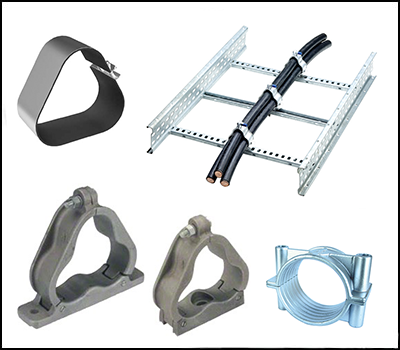Who thought that something bearing a simple look of a cable cleat is now one of the debatable keynotes in the electrical industry taking a strong core drift of safety in the cabling system to the next level. Take the cable cleats away and the costly damage posed by the short circuit and its adverse effect on the cable management system is obvious. This article is a simple and precise detail about the need and importance of the cable cleats. With highlights on how it helps to project the peak faults and deal with the mechanical forces, this article will drive you to the goodies of the cable cleats.
The critical issue lies in the unawareness of the importance of cable cleats. Rather than being considered as a vital component of the cable management system, it is lumped in with that of the electric sundries. Well, for the companies having tight budgets, It is clearly seen a fair means of reducing the cost. But the end result can be more dangerous as it can double the cost of rework in addition to the increased risk of human life as well. This is why this article explains in detail the salient goodies of the cable cleats.
How the mapping out of the peak faults under short circuit conditions is one of the goodies of the cable cleats?
At the time of the design of the cabling system and electrical installation, the maximal projected short circuit load is calculated that derives the force between the conductors under short circuit conditions. With this, the exact cable cleat with precise spacing can easily be determined. The cable cleat range varies from each other due to different attributes and mechanical strength. As the forces between the conductor under a short circuit condition has been calculated properly, the core and key success factor for installing a perfect cable cleat is an accurate calculation of the correct spacing of the specific cleat. In case the type of cable cleat has been changed, the recalculation of the spacing takes place for the mechanical strength of the cable cleat. This helps to deal with the mechanical load and also is prepared to face the fault level conditions without damaging the cabling system or risk to human life.
One of the way to project peak faults and to assure the performance of the cable cleat is through a short circuit test that has a fixed standard set by IEC 61914:2009 that can help compare results of different types of the cleats. Be it a single way cable cleat, LSOH cable cleat, trefoil aluminium cable cleat, two bolt cable cleat or many other epoxy coated cable cleats to suit any kind of climate like heavy industrial, contaminated areas or pollution. Due to the dynamic forces involved in the testing process, the tensile test proves to be a failure for a cleat that withstands a certain level of mechanical load. For this, a rigorous and well defined short circuit testing process is being practiced that helps to dig out the peak faults and to deal with the mechanical forces.
Usually this becomes one of the vital stage for the cable cleat manufacturers to derive a fault level at which they wish to examine the cleat. Basic pedagogy to be followed at the time of the short circuit test includes, the cable used must be unarmoured single core standard copper conductor cable, the intended function of maintaining the cable in place with a strong hold should not be affected with any kind of test failure, the intermediate restrains and cable cleats used should be equipped with no missing parts, there shall be no visible damage or cuts in the outer sheath of the cable that is being caused by the cleats and may more conditions to perform a perfect short circuit test. The second way to map out peak faults involves a formula IEC 61914:2009 to calculate the theoretical forces among the conductors under short circuit condition.
The rule of thumb for selecting the best suited cable cleat
Firstly, collecting proper details on the installation environment, external bodies, cable configuration, mounting structure, peak short circuit fault level, cable diameter and short circuit fault level. With these details the cable cleat manufacturer can help to derive a best suited type of cleat for your project. They perform the required tests to check on the short circuit conditions, mechanical load and other dynamic forces between the conductors.
The cable cleat consultant or the cable cleat fabricators or in some cases the cable cleat distributors take a 360 degree view on all the attributes required to be considered for a specific project like, does the cable need any fire performance? Is it a single core cable or a multi core cable type? How the cable cleat will support the mechanical load? What kind of cable formation to be designed, be it parallel, trefoil or a flat form? How many cable cleats are required? Thus the factors that are considered while selecting the right type of cable cleat for your project is one of the sensitive stage to make your project a big success with less maintenance, more performance, low cost and time saving.
BICC Components Limited (BICC) has achieved expertise in manufacturing and distribution of cable glands, cable cleats, copper terminals, cable fittings and other cable accessories. We have a strong team of engineer and technician that can perform a short circuit test and other operations to pick out the best suited cable cleat for a particular application. With an upgraded technology, high level of R&D and varied customized range of products, we have a good customer base from different sectors. We look forward to solve your queries! In order to reach us, visit https://www.bicccomponents.uk.com/contact/. You can also look into our cable cleat range, visit https://www.bicccomponents.uk.com/cable-cleats/
 SUBSCRIBE TO OUR BLOG
SUBSCRIBE TO OUR BLOG
